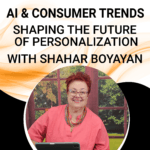
AI and Consumer Trends: Shaping the Future of Personalization with Shahar Boyayan
Is AI making us more connected—or just more lonely? As smart devices anticipate our every move and hyper-personalization reshapes business, we’re becoming more isolated than ever. In this episode of Innovation Tales, Alexandre Nevski and AI expert Shahar Boyayan dive into the paradox of AI-driven convenience: How do businesses use automation without losing the human touch? Where’s the line between personalization and privacy invasion? And what happens when consumers expect brands to really see them? Tune in for a thought-provoking look at the future of AI, authenticity, and consumer trust.
Key Takeaways
- Automate with purpose: Use AI to handle repetitive tasks but ensure critical touchpoints remain human-led.
- Prioritize transparency: Clearly communicate how AI-driven personalization works and allow customers to control their data.
- Emphasize authenticity: Consumers engage more with brands that feel real. Show behind-the-scenes content, admit imperfections, and foster genuine interactions.
- Stay adaptable: AI technology evolves rapidly. Businesses that remain flexible and open to change will be best positioned for success.
AI’s Growing Influence on Consumer Behavior

AI is already embedded in our daily lives. From smartwatches that monitor stress levels to smart homes that anticipate our routines, consumers are becoming increasingly comfortable with AI-driven conveniences. However, this growing reliance on AI is also shaping consumer expectations in new ways. Shahar Boyayan predicts that in 2025 and beyond, we’ll see one of the biggest shifts in consumer behavior since the pandemic—one that will redefine how brands engage with their audiences.
“It’s actually becoming an extension of ourselves. Many times we are not even conscious that it’s happening, but we are getting so accustomed to these devices that now they feel like a part of us.”
Hyper-Personalization: A Double-Edged Sword
Personalization has long been a goal for businesses, but AI takes it to another level. Imagine a restaurant menu that remembers your last order and suggests variations based on your preferences. Or a hairstylist who, with AI-driven reminders, knows exactly when you need your next appointment. While these innovations enhance customer experiences, they also raise questions about privacy and data ethics.
As businesses push for deeper personalization, they must also consider consumer concerns. How much data collection is too much? At what point does AI-driven personalization cross the line from helpful to invasive? Companies need to be transparent about data usage and give consumers control over how their information is used.
“One in every five Americans feels extremely lonely, and one in every three Americans thinks they have a real friend. So when I interact with a business, I want to be seen—I don’t want to be invisible.”
AI’s Role in Business Efficiency
One of the most practical applications of AI is in automating repetitive tasks. Businesses can use AI for scheduling, answering common customer inquiries, and optimizing workflows—freeing up time for employees to focus on high-value tasks. Shahar highlights that the key is to identify areas where consistency is crucial and automate those processes while leaving room for human creativity and connection.
“I would first start with a list of the 10 things you hate to do in your business. Those are the ones you should automate. Free up your time so you can focus on things that truly matter.”
Finding the Right Balance: Automation vs. Human Touch
Despite the benefits of AI, businesses cannot afford to lose the human element. Consumers still crave authenticity, emotional connections, and real human interactions. Successful brands will be those that blend automation with genuine human engagement.
Take social media, for example. AI can generate content, but audiences engage more with brands that show real behind-the-scenes moments, admit mistakes, and share raw, unpolished experiences. The same applies to customer service—AI chatbots may handle FAQs, but complex issues still require a human touch.
“The more I go with the traditional, polished, corporate communication style, the more I lose the consumer. They don’t want perfection—they want to see who you really are.”
Challenges and Ethical Considerations
AI-driven hyper-personalization and automation also come with risks. Shahar warns that as consumers become more reliant on AI, they may struggle with real-world interactions. The rise of AI companions, from virtual assistants to AI-generated relationships, could further increase social isolation. Businesses must be mindful of these societal implications and strive to use AI responsibly.
“We have to be very vocal about where we set the limits. Our home is our most intimate environment—how much do we want AI listening and recording? And who controls that data?”
Final Thoughts
AI is a powerful tool that can revolutionize the way businesses interact with customers. However, the key to success lies in striking the right balance between automation and authenticity. Brands that leverage AI effectively—while maintaining transparency and human connection—will be the ones that thrive in the years ahead.

Want to explore more about AI’s impact on consumer behavior? Check out AI Consumer Trends for 2025, Shahar Boyayan’s in-depth report on how businesses can navigate AI-driven personalization while maintaining trust and authenticity.
What Do You Think?
Where do you see the biggest opportunities and risks in AI-driven business strategies? Share your thoughts on LinkedIn!

Episode timeline:
- 00:00 Introduction to AI in 2025
- 00:00 Balancing Automation and Authenticity
- 00:00 Guest Introduction: Shahar Boyayan
- 00:00 AI's Impact on Consumer Behavior
- 00:00 Hyper-Personalization and Privacy Concerns
- 00:00 The Role of Human Touch in Business
- 00:00 Leveraging AI for Business Efficiency
- 00:00 Challenges and Ethical Considerations
- 00:00 Conclusion and Key Takeaways





